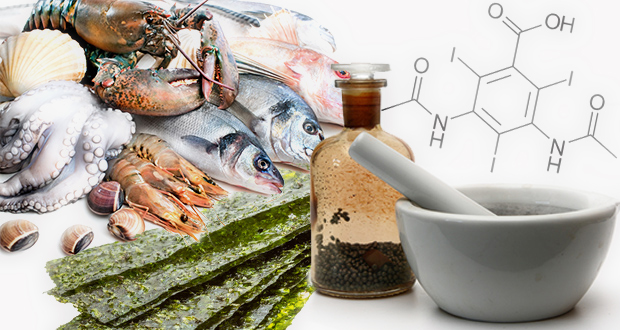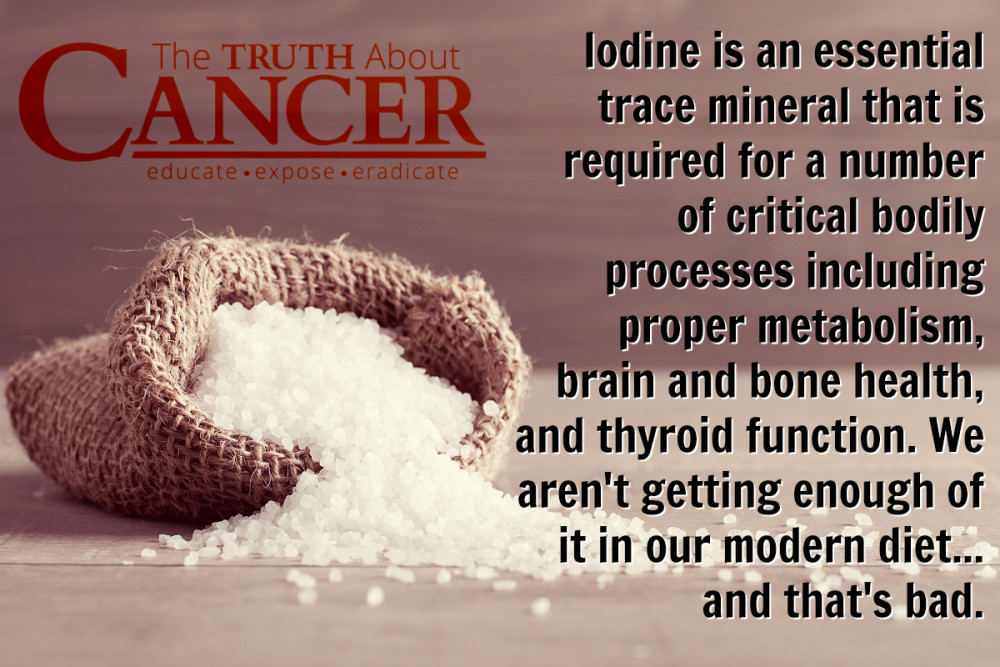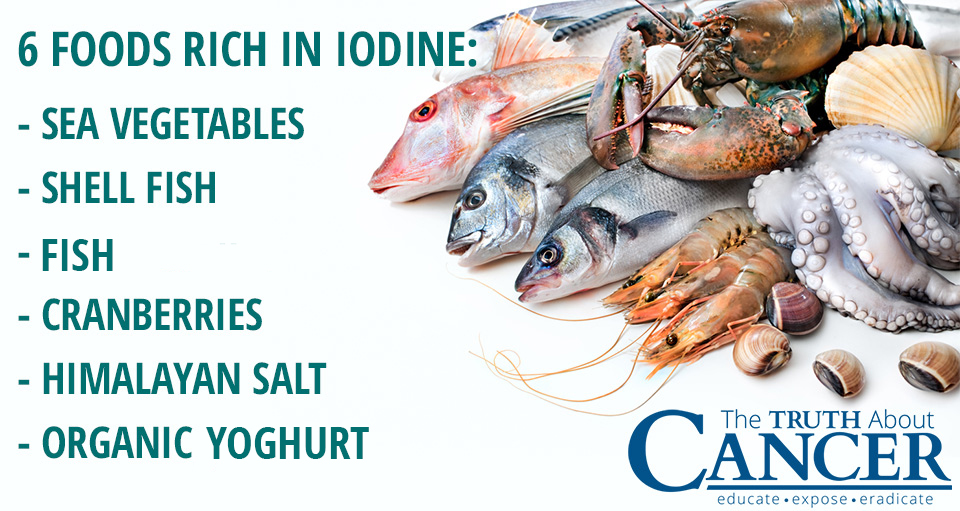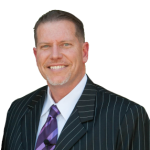What if I told you that an essential trace mineral that’s been a staple of traditional diets for many centuries is all but missing from the modern food supply? What if I also told you that this elemental micronutrient (which serves as a basic building block for hormone production and healthy growth and development), can reduce your breast cancer risk?
This nutrient is known as iodine, and chances are you’re not getting enough of it from the foods you eat every day to maintain optimal health. Iodine is absolutely essential for a number of critical bodily processes, including proper metabolism, brain and bone health, and thyroid function. But there’s currently an epidemic of iodine deficiency that’s causing many people to suffer from a host of chronic health conditions.
Breast cancer is one such condition that’s directly implicated as a health consequence of iodine deficiency. Breast cancer prevention should be top of mind for women and undertaken before the appearance of breast cancer signs. Therefore it’s important to understand the science behind iodine and how it’s been shown to be effective at both preventing and helping to combat breast cancer without the need for radiation or chemotherapy.
Is Iodine Supplementation Safe?
Just so we’re clear, iodine isn’t some miracle drug or cure for cancer. It’s a nutrient that your body requires as part of its natural biochemical makeup. Iodine keeps your body from malfunctioning, so to speak, and when you aren’t getting enough of it, your defenses against cancer are weakened.
Iodine is stored and used all throughout your body. This includes your thyroid and salivary glands, as well as in your brain, your breasts and ovaries (if you’re a woman), your eyes, and in your cerebrospinal fluid. It functions as a modulator for each of these important systems, which use it to perform their respective functions.
The recommended daily allowance (RDA) for iodine in the U.S. is a mere 150 micrograms (mcg). Small quantities of iodine are often added to common table salt as a public health measure to help people attain this amount. But many progressive physicians and researchers have found that this amount of iodine is too low to protect against serious illnesses like cancer.
Dr. Guy Abraham, MD, a physician from the University of California, Los Angeles (UCLA), explains in his book The Safe and Effective Implementation of Orthoiodosupplementation in Medical Practice that iodine can be safely consumed at levels up to 100,000 times higher than the government’s RDA.
This translates to 15 grams of iodine daily, which Dr. Abraham and his colleagues say is a safe amount for humans. I wouldn’t actually recommend taking this much iodine unless you have a serious health condition that might benefit from it, and only with the guidance of a qualified physician. But knowing that you could take this amount and not be harmed demonstrates the relative safety of this largely misunderstood micronutrient.
Iodine Deficiency and Breast Cancer Risk
A much more realistic amount for daily maintenance, and one that Dr. Abraham recommends personally, is 12.5 milligrams (mg) per day. This is roughly the amount that Japanese people consume as part of their normal diet. Iodine is plentiful in seaweed, seafood, and other foods native to Japan, but not so much here in the U.S. Hence the need for supplementation.
While the 150 mcg RDA for iodine that the government recommends might help protect you against goiter, it won’t protect against cancer. Taking iodine at a therapeutic dose of 12.5 mg daily or higher can help prevent and even reverse several conditions. According to Dr. Abraham, these conditions include: hypothyroidism, fibrocystic disease, diabetes, migraine headaches, breast nodules and cysts, fibromyalgia, and more.
Studies he references in his work reveal that iodine deficiency increases a woman’s risk of breast cancer, and vice versa. Iodine sufficiency has an anti-proliferative effect on human breast cancer cells (meaning cancer cells don’t increase in number). Both animal studies and human case studies confirm this, demonstrating an inverse relationship between iodine intake and breast cancer risk.
Dr. David Brownstein, MD, another iodine expert and researcher, in his book Iodine, reports of three case studies where women diagnosed with breast cancer successfully overcame their condition by taking iodine. Each of these women took 50 mg of iodine daily, and all were later cleared of their diagnoses. This is over 30 times the U.S. recommended daily allowance for iodine.
Contained within the more than 80 research papers he published over a 30-year span during his career, Dr. Bernard Eskin also uncovered evidence that iodine is an effective remedy for fibrocystic breast disease, a pre-cancerous health condition in which lumps form in the breast. Iodine breaks these lumps apart and, in effect, helps prevent nodules and other abnormalities from turning into cancer.
Iodine Supplements and Breast Cancer Prevention
If you decide to start supplementing with iodine, be sure not to ingest the standard iodine tinctures sold at drug stores. These are usually brownish-orange in color and are sold for topical rather than internal use. Ingestible forms of iodine include potassium iodide (Iodoral is one great option), Lugol’s iodine solution, and Nascent iodine.
I won’t get into too many details about each of these, but I will say that Nascent iodine is particularly beneficial because it contains iodine in atomic rather than molecular form. This makes it more energetically potent and bioavailable for your thyroid gland, which is where most of the iodine in your body is stored.
The following quote is from the late Dr. Albert Szent Györgi, a Nobel laureate physician who’s been credited as being the first to discover vitamin C. He sums up the healing potential of iodine and its amazing ability to fill an important nutritional gap that many Americans lack:
When I was a medical student, iodine in the form of KI (potassium iodide) was the universal medicine. Nobody knew what it did, but it did something and did something good. We students used to sum up the situation in this little rhyme: If ye don’t know where, what, and why, prescribe ye then K and I.”
If you are experiencing any of the conditions mentioned in this article, be sure to talk to a healthcare professional to see if iodine supplementation may be right for you.
According to Dr. Abraham, taking a daily therapeutic dose of iodine can improve conditions such as: hypothyroidism, fibrocystic disease, diabetes, migraine headaches, breast nodules and cysts, and fibromyalgia.
When you are not getting enough iodine, your defenses against cancer are weakened.
Go here to learn more about organic nascent iodine>>
Article Summary
Iodine is an essential trace mineral that is required for a number of critical bodily processes including proper metabolism, brain and bone health, and thyroid function.
There is an epidemic of iodine deficiency that’s causing many people to suffer from a host of chronic health conditions, including breast cancer.
The recommended daily allowance (RDA) for iodine in the U.S. is a mere 150 micrograms (mcg).
Dr. Guy Abraham, MD, says that iodine can be safely consumed at levels up to 100,000 times higher than the government’s RDA. However, a more realistic amount for daily maintenance that Dr. Abraham recommends is 12.5 milligrams (mg) per day.
If you supplement with iodine, do NOT ingest the standard iodine tinctures sold at drug stores. Forms of iodine considered safe to swallow include potassium iodide, Lugol’s iodine solution, and Nascent iodine.





















yes, this is great..also keep in mind that consuming Organic Sulfur is a great way to prevent and can really help get well from cancer.
I am a second time diagnosed breast cancer patient. I take 50 mg (Iodoral) iodine/day. How much & how often do I need of organic sulfer/day ?
I am currently taking 1.5 mg potassium iodide, recommended 1 per day. That seems to be way below what I have read in this article.
What should I increase it to?
I was told that we can buy a bottle of iodine (the clear kind) at any drugstore, and put it on our skin….it absorps !!! I have been doing this for the past 3 years, after having a cancerous lump in my breast, and reading about the relationship between low iodine, and breast cancer risk.
Isn’t there a risk in taking iodine if you are taking medication for underactive thyroid? I have had breast cancer but am reluctant to start iodine.
How does one know if they are iodine deficient? Before adding the mineral to the diet is there a test to determine the level in your body?
This article states that Himalayan Salt is rich in Iodine. According to an article by Dr. Mercola–just the opposite is true!! If you use Himalayan salt you have to add Iodine to your diet!!!
What about kelp tablets?
Thank You for your information. How about Formula II IOSOL, ammonium Iodide? Is that in the “not recommended” list?
I would be very careful with iodine. I personally had awful side-effects from taking 1 mg of iodine for 5 days (severe tachycardia for months). I stopped taking it then but I still (2.5 years later) suffer from that mistake. I can’t eat a lot of seaweed or fish now even though I had no problem with these foods before. Please be careful with it, especially if you are diagnosed as hypothyroid (even though I wasn’t and still am not) or have symptoms of hypo (fatigue, cold feet and hands, weight gain etc) but are not formally diagnosed. TAKE extra caution with iodine intake. It might throw you into a full blown Hashimoto’s disease with the VERY unpleasant symptoms. Everyone is different and I believe I am a rare case with such a severe reaction (tachycardia) but the fact of developing Hashimoto’s disease after intake of iodine is well documented. If you decide you want to try Iodine, start SLOWLY with micro-grams, not milligrams. Increase slowly and monitor your thyroid antibodies (blood test) and the way you feel. Btw, some practitioners believe that Japanese never consumed 12 mg of iodine daily and that it was a miscalculation. The correct number would be a little over 1 mg.
Hi Cheryl Z: How are you today?
Get iodoral (12.5 mg) or iodizyme (6.25 mg) on amazon. They’re both great brands. If you get a headache, it was too strong for you. Cut down the dosage and increase it slowly, till you can take the high dosage.
I have had fibrocystic breast disease for 20+ years and the doctors simply say not to worry. Thanks to the truth about cancer series, I have been putting iodine solution on my breasts almost daily. A cyst that felt as big around as my thumbnail dissolved in about 8 weeks. Another that felt almost as long as my entire thumb, has been slowly getting smaller and less defined. I have been using iodine for 11 months now and will continue for a long time after the cyst can no longer be felt.
I put Nascent iodine on my skin instead of taking it orally. Is this sufficient?
Does Himalayan salt have enough iodine if you don’t supplement or eat one of the mentioned foods every day?
if organic yohurt is a recommended iodine rich food then I wonder what acout organic Kefir?
I was taking Iodoral for months and became HYPERTHYROID. Nasty business, swollen legs, palpitations, sleeplessness. It took a good six months after I stopped taking it for my thyroid to normalize… Please BE CAREFUL!!
How much were you taking that you became hyperthyroid?? Don’t you have to take too much for that to happen?
Seaweed, especially kelp/kombu is a natural source of iodine. My ND suggested eating a small piece daily.
Carol D, how many drops pf iodine do you use on the skin of your breast and what concentration?.
Hi Monica, I use Lugol’s 2% solution. I started using 1 drop on each breast, every other day just to see how it made me feel. With no adverse side effects, i gradually increased to about 4 drops on each, almost every day. I read that it is good to take occasional breaks from it. Often, I put 4-6 drops on the side that still has a cyst that I can feel. I hope that you have good results with it as well! Listen to your body!
I eat heaps of seaweed every day!
Iodine supplementation will make breast cysts go away. You can take it like any vitamin. There is no need to apply it directly to the breast. Excess is excreted in the urine. I would be more worried about deficiency than about taking too much. Ovarian cysts also respond to iodine supplementation. Men need iodine too. Cancer is a lucrative business. Doctors who have dollar signs in mind will warn you about potential risk (which is practically non-existent), while ignoring the potential risk of cancer avoided. The cost should be compared with eventual cost of Cancer treatment; or, as in my case, having to have the cyst lanced. The weight loss business is also going to be reluctant to inform you that iodine deficiency is a common reason for obesity. It is at least a contributing factor. Diabetes may not be directly related to iodine, but I have a strong suspicion that by taking iodine and improving thyroid function, which triggers fat burning metabolism, the incidence of diabetes might be reduced. That is just me. I am a consumer not an academic or professional. Take my opinion at face value and do your own research. Also, I just read that taking organic cold pressed coconut oil twice a day, 20 grams, revearsed the symptoms of Alziemers in clinical trials. If I’m living longer due to iodine, I want to stay mentally healthy. By the way iodine helps me that way too. A sluggish metabolism means fuzzy sluggish thinking. Iodine supplementation, mild exercise, sunshine, and organic nonGMO food: I am getting older but I feel young at heart.
Excellent information, thank you. What amount of iodine to take orally?
Do these people present anything about PROSTATE cancer? Or are they only concerned with women?
Carol & Monica, Have you tried Frankincense essential oil for your breasts? When I use that &/or a damaged DNA repair eo blend, I notice less fiberous breast matter. At my Chiropractor’s advice, I just began taking 3 tablets of MinTran (Standard Process) which has iodine, magnesium, & calcium. I did get a headache the first night, so I backed it down. Mineral (& vitamin) deficiency is vital in being well. I struggled for 30+ years before I found an ND who began to help my wellness journey.
Linda, I have heard of frankincense essential oil but have not tried it because I am getting positive results with iodine. I am considering changing to iodine drops orally (diluted) so maybe it will be a good time to try frankincense. Thanks!
LOL and so say all of us….try asking this question at Bobbys health shop you will get an answer
Patch test reveals amount of deficiency. Put brownish liquid iodine on (2 inch square) on abdomen & cover w telfa pad. check every 5 hours to see when it gets absorbed. If it is still there in24 hours, you have not absorbed any & proves you have plenty. The sooner it lightens/absorbs the more you need. I take 50mg iodoral/day. I attribute the iodine to why I never blistered, or had opens sores/wounds during radiation. Doctors were amazed. Being a cancer patient, I learned to never get deficient in iodine.
Sincerely, Melinda
Be very CAREFUL doing this! I read to do this in a book. I put dark iodine patch on my abdominal every day and it disappeared within 10 minutes. I assumed that I had an iodine deficiency like the article indicated if it disappeared quickly. I thought I was hypothyroid. I had my blood tested previously several times but doctor said my thyroid was normal. I wish I had asked to see numbers so I would have known that I was close to hyperthyroid. I had cold hands, very fatigued, couldn’t lose weight, and had other symptoms of being hypothyroid. I did the iodine patches for months. Finally did T3, T4, and TSH bloodwork and was diagnosed hyperthyroid with Graves Disease. You have to avoid iodine with Graves Disease. I have been taking a low dose of methamazole every day now for 5 years under testing of an endocrinologist to keep TSH from getting too low. Get bloodwork and know your numbers. My resting pulse was also around 100 bpm because of doing iodine patches every day. That is what made me get bloodwork run again.
Where can I purchase the iodine recommended in the article ?
I look forward to your reply.
Thank you.
Judy